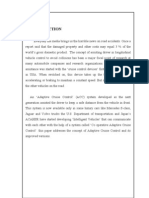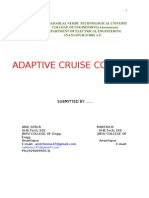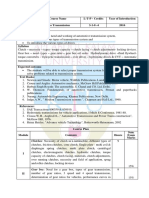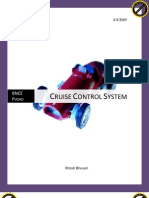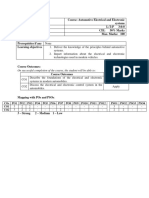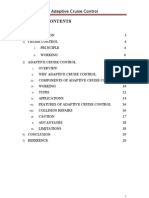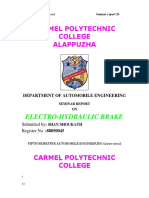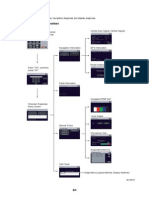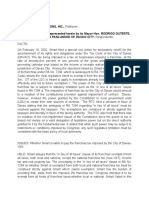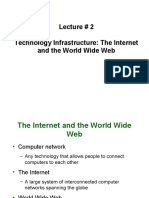Adaptive Cruise Control
Uploaded by
Chandu ChinemeneniAdaptive Cruise Control
Uploaded by
Chandu ChinemeneniADAPTIVE CRUISE CONTROL
1. Introduction
Adaptive Cruise Control (ACC) is an automotive feature that allows a vehicle's cruise control system to adapt the vehicle's speed to the traffic environment. A radar system attached to the front of the vehicle is used to detect whether slower moving vehicles are in the ACC vehicles path. If a slower moving vehicle is detected, the ACC system will slow the vehicle down and control the clearance, or time gap, between the ACC vehicle and the forward vehicle. If the system detects that the forward vehicle is no longer in the ACC vehicle's path, the ACC system will accelerate the vehicle back to its set cruise control speed. This operation allows the ACC vehicle to autonomously slow down and speed up with traffic without intervention from the driver. The method by which the ACC vehicle's speed is controlled is via engine throttle control and limited brake operation.
S.V.COLLEGE OF ENGINEERING
DEPT OF EEE
Page 1
ADAPTIVE CRUISE CONTROL
2. ADAPTIVE CRUISE CONTROL (ACC)
2.1 PRINCIPLE OF ACC:
ACC works by detecting the distance and speed of the vehicles ahead by using either Lidar system or a Radar system .The time taken by the transmission and reception is the key of the distance measurement while the shift in frequency of the reflected beam by Doppler Effect is measured to know the speed. According to this, the brake and throttle controls are done to keep the vehicle the vehicle in a safe position with respect to the other. These systems are characterized by a moderately low level of brake and throttle authority. These are predominantly designed for highway applications with rather homogenous traffic behavior. The second generation of ACC is the Stop and Go Cruise Control (SACC) whose objective is to offer the customer longitudinal support on cruise control at lower speeds down to zero velocity. The SACC can help a driver in situations where all lanes are occupied by vehicles or where it is not possible to set a constant speed or in a frequently stopped and congested traffic. There is a clear distinction between ACC and SACC with respect to stationary targets. The ACC philosophy is that it will be operated in well structured roads with an orderly traffic flow with speed of vehicles around 40km/hour. While SACC system should be able to deal with stationary targets because within its area of operation the system will encounter such objects very frequently.
2.2 CONSTITUENTS OF AN ACC SYSTEM:
1. A sensor (LIDAR or RADAR) usually kept behind the grill of the vehicle to obtain the information regarding the vehicle ahead. The relevant target data may be velocity, distance, angular position and lateral acceleration. 2. Longitudinal controller which receives the sensor data and process it to generate the commands to the actuators of brakes throttle or gear box using Control Area Network (CAN) of the vehicle.
S.V.COLLEGE OF ENGINEERING
DEPT OF EEE
Page 2
ADAPTIVE CRUISE CONTROL
3. SENSOR OPTIONS
Currently four means of object detection are technically feasible and applicable in a vehicle environment. They are 1. RADAR 2. LIDAR 3. VISION SENSORS 4. ULTRASONIC SENSOR The first ACC system used LIDAR sensor.
3.1 LIDAR (Light Detection and Ranging)
The first acc system introduced by Toyota used this method. By measuring the beat frequency difference between a Frequency Modulated Continuous light Wave (FMCW) and its reflection [3].
A company named Vorad Technologies has developed a system which measured up to one hundred meters. A low powered, high frequency modulated laser diode was used to generate the light signal.
S.V.COLLEGE OF ENGINEERING
DEPT OF EEE
Page 3
ADAPTIVE CRUISE CONTROL
Most of the current acc systems are based on 77GHz RADAR sensors. The RADAR systems have the great advantage that the relative velocity can be measured directly, and the performance is not affected by heavy rain and fog. LIDAR system is of low cost and provides good angular resolution although these weather conditions restrict its use within a 30 to 40 meters range.
3.2 RADAR (Radio Detection and Ranging)
RADAR is an electromagnetic system for the detection and location of reflecting objects like air crafts, ships, space crafts or vehicles. It is operated by radiating energy into space and detecting the echo signal reflected from an object (target) the reflected energy is not only indicative of the presence but on comparison with the transmitted signal, other information of the target can be obtained. The currently used Pulse Doppler RADAR uses the principle of Doppler effect in determining the velocity of the target [5].
3.2.1 PULSE DOPPLER RADAR
The continuous wave oscillator produces the signal to be transmitted and it is pulse modulated and power amplified. The duplexer is a switching device which is fast-acting to
S.V.COLLEGE OF ENGINEERING
DEPT OF EEE
Page 4
ADAPTIVE CRUISE CONTROL
switch the single antenna from transmitter to receiver and back. The duplexer is a gas-discharge device called TR-switch. The high power pulse from transmitter causes the device to breakdown and to protect the receiver. On reception, duplexer directs the echo signal to the receiver. The detector demodulates the received signal and the Doppler filter removes the noise and outputs the frequency shift fd.
3.2.2 EFFECT OF DOPPLER SHIFT
The transmitter generates a continuous sinusoidal oscillation at frequency ft which is then radiated by the antenna. On reflection by a moving object, the transmitted signal is shifted by the Doppler Effect by fd. If the range to the target is R, total number of wavelength is in the two way- path is given by, n = 2R/ The phase change corresponding to each =2 So total phase change, p=2n =2(2R/ ) So, if target moves, R changes and hence also changes. Now, the rate of change of phase, or the angular frequency is W=d /dt =4 (df/dt)/
Let Vr be the linear velocity, called as radial velocity Wd = 4 Vr/ Fd=2Vr / But = ft, the transmitted velocity. =2 fd.
S.V.COLLEGE OF ENGINEERING
DEPT OF EEE
Page 5
ADAPTIVE CRUISE CONTROL
Fd= (2c Vr)/ ft So by measuring the shift, Vr is found. The plus sign indicates that the target and the transmitter are closing in. i.e. if the target is near, the echoed signal will have larger frequency.
3.2.3 RADAR ANTENNA SCHEMES:
Radar systems employ a variety of sensing and processing methods to determine the position and speed of vehicles ahead. Two such important schemes are: 1. mechanically steered antenna 2. electronically steered antenna
Mechanically steered antenna:
A parabolic reflector is used as mechanically steered antenna. The parabolic surface is illuminated by the source of energy placed at the focus of the parabola. Rotating about its axis, a circular parabola is formed. A symmetrical beam can be thus obtained. The rays originating from focus are reflected parallel to the axis of parabola. [fig (3).]
Fig 3.Parabolic reflector antenna
S.V.COLLEGE OF ENGINEERING
DEPT OF EEE
Page 6
ADAPTIVE CRUISE CONTROL
Electronically steered phased array radar antenna
A phased array is a directive antenna made up of a number of individual antennas, or radiating elements. The radiation pattern is determined by the amplitude and phase of current at each of its elements. It has the advantage of being able to have its beam electronically steered in angles by changing phase of current at each element. The beam of a large fixed phased array antenna is therefore can be rapidly steered from one direction to another without mechanical positioning [1, 5].
Consider the following figure with N elements placed (equally separated) with a distanced apart. Suppose they have uniform response to signals from all directions. Element 1 is taken as reference with zero phase.
Fig 4. Phased array elements (example: reception of the beams)
S.V.COLLEGE OF ENGINEERING
DEPT OF EEE
Page 7
ADAPTIVE CRUISE CONTROL
From simple geometry, we can get difference between path lengths of beam1 and that of beam2 is x = d sin , where is the angle of incidence of the beams. This gives phase = 2 (d sin )/ , where is the wave length of the difference between adjacent elements as
signal. But if the current through a ferro electric element is changed, the dielectric constant is changed since electron density is changed, and for an electromagnetic radiation, =2 x/ =2 xf/v, here the velocity v = 1/ ( Hence =2 xf ( ). =f )
So if is changed also changes and inserting N phase shifting elements to steer the beam, we can obtain an electronically steered beam. Regardless of the scanning mechanism the radars typically operate in the millimeter wave region at 76-77 GHz. The system should be mounted inside the front grille of the car as shown in figure (5). So its size is to be small. A typical radar produced by Delphi-Delco Electronic systems is having the size of two stacked paperback books(14x7x10 cm)[1].
3.3 FUSION SENSOR
The new sensor system introduced by Fujitsu Ten Ltd. and Honda through their PATH program includes millimeter wave radar linked to a 640x480 pixel stereo camera with a 40 degree viewing angle. These two parts work together to track the car from the non-moving objects. While RADAR target is the cars rear bumper, the stereo camera is constantly captures all objects in its field of view.
S.V.COLLEGE OF ENGINEERING
DEPT OF EEE
Page 8
ADAPTIVE CRUISE CONTROL
Fig5. A prototype of a car with fusion sensor arrangement
Fig 6.Block diagram of sensing and controlling process
S.V.COLLEGE OF ENGINEERING
DEPT OF EEE
Page 9
ADAPTIVE CRUISE CONTROL
The image processor measures the distances to the objects through triangulation method. This method includes an algorithm based on the detection of the vertical edges and distance. Incorporating both the 16-degree field of view of radar and 40-degree field of view of camera enhances the performance in tight curves [4].
S.V.COLLEGE OF ENGINEERING
DEPT OF EEE
Page 10
ADAPTIVE CRUISE CONTROL
4. SPACE OF MANEUVERABILITYAND STOPPING DISTANCE
The space of maneuverability is the space required by the driver to maneuver a vehicle. An average driver uses larger sideways acceleration while vehicle speed is low. If the curve radius of a possible trajectory is r for a given velocity v and sideways acceleration ay ,then r= / ay [2].so to get the required r ,when v is low, ay is also to be low correspondingly.
The stopping distance is given by, Ds = .5 u /ax + td u, where u is the initial speed td is the time taken by the system to receive and process the sensor data and ax is the acceleration of the vehicle .the figure shows the detection of edges of the preceding vehicles.
Fig 7.Detection of vehicle edges by the fusion sensor
S.V.COLLEGE OF ENGINEERING
DEPT OF EEE
Page 11
ADAPTIVE CRUISE CONTROL
5 CONTROLLER
The controller translates the situation into appropriate actions through brake and pedal and throttle control actions. Depending on the present traffic situation, two types of controls are possible. 1. Speed control 2. Headway control
If there is no vehicle presently in front, then the speed is controlled about a set point just as in conventional cruise control. But in order to keep a safe distance between the vehicle s, the headway control is required.
5.1ARTIFICIAL COGNITION
The conversion of raw information from sensors to control actions by the two steps:1. Analyzing the traffic conditions 2. Deciding on a particular situation The controller translates the desired situation into appropriate control action through brake and throttle actuation.[2]. The controller concept is simplified in the flow-diagram:
S.V.COLLEGE OF ENGINEERING
DEPT OF EEE
Page 12
ADAPTIVE CRUISE CONTROL
Fig 8.Flow diagram of controlling process
5.2. EXAMPLE OF ADAPTIVE CRUISE CONTROLLER (MOTOROLA ACC)
The Motorola ACC constitutes a DSP module having MGT5200 which provides a multiply-accumulator. The sensor data such as Radar information, that from camera and an IR sensor are processed in it, to generate the input data for the controller modules like HC12 and MPC565.[6].
S.V.COLLEGE OF ENGINEERING
DEPT OF EEE
Page 13
ADAPTIVE CRUISE CONTROL
Fig9. Motorola ACC 5.2.1 MPC565 It is a throttle controller or an engine speed controller. It consists of the following features 1. SRAM (1MB to10 MB) 2. FLASH 1MB 3. EEPROM (4KB to 32 KB) 4. Real time clock 5. 4 x UART interfaces 6. 3 X CAN interfaces 7. 64-bit floating point unit.
S.V.COLLEGE OF ENGINEERING
DEPT OF EEE
Page 14
ADAPTIVE CRUISE CONTROL
The MPC 565 can be programmed to generate the control signals according to the sensor data. The Phycore-MPC 565 developers are available to program and develop the desired controller. The throttle valve is actuated and the air intake is controlled so the requirement of fuel for the right proportion with the air also increases. So more fuel is injected and engine speed is changed.
5.2.2 HC12
The HC12 is a breaking controller which receives data from the wheel speed sensors and from the DSP module. It generates the braking control signal.
5.2.3 CAN (Control Area Network) BUS
CAN BUS is the network established between microcontrollers. It is a2-wire, halfduplex, high speed network for high speed high speed applications with short messages. It can theoretically link up to 2032 devices on a network. But today the practical limit is 110 devices. It offers high speed communication rate up to 1Mbits per second and allows real time control. [7]. Each module in the ACC connected to the CAN is called a node. All are acting as transceivers. The CAN bus carries data to and from all nodes and provides quicker control transfer to each module. The actuator used for throttle control is a solenoid actuator. The signal through the coil can push or pull the plunger.
S.V.COLLEGE OF ENGINEERING
DEPT OF EEE
Page 15
ADAPTIVE CRUISE CONTROL
6. CO OPERATIVE ADAPTIVE CRUISE CONTROL [CACC]
Though conventional ACC and SACC are still expensive novelties, the next generation called Cooperative ACC is already being tested. While ACC can respond to the difference between its own behavior and that of the preceding vehicle, the CACC system allows the vehicles to communicate and to work together to avoid collision.[2,4]. Partners of Advanced Transit Highways (PATH) a program of California Department of Transportation and University of California with companies like Honda conducted an experiment in which three test vehicles used a communication protocol in which the lead car can broadcast information about its speed, acceleration ,breaking capacity to the rest of the groups in every 20ms. PATH is dedicated to develop systems that allow cars to set up platoons of vehicles in which the cars communicate with each other by exchanging signals using protocols like Bluetooth.
6.1. MAIN POSTULATIONS ABOUT CACC:
1. In CACC mode, the preceding vehicles can communicate actively with the following vehicles so that their speed can be coordinated with each other. 2. Because communication is quicker, more reliable and responsive compared to
autonomous sensing as in ACC. 3. Because braking rates, breaking capacity and other important information about the vehicles can be exchanged, safer and closer vehicle traffic is possible.
S.V.COLLEGE OF ENGINEERING
DEPT OF EEE
Page 16
ADAPTIVE CRUISE CONTROL
Fig10. Under CACC, both the leading and following vehicles are electronically tied to a virtual reference vehicle, as well as to each other.
S.V.COLLEGE OF ENGINEERING
DEPT OF EEE
Page 17
ADAPTIVE CRUISE CONTROL
7. DEFINITIONS
Adaptive Cruise Control (ACC) An enhancement to a conventional cruise control system which allows the ACC vehicle to follow a forward vehicle at an appropriate distance. ACC vehicle the subject vehicle equipped with the ACC system. active brake control a function which causes application of the brakes without driver application of the brake pedal. clearance distance from the forward vehicle's trailing surface to the ACC vehicle's leading surface. forward vehicle any one of the vehicles in front of and moving in the same direction and traveling on the same roadway as the ACC vehicle. set speed the desired cruise control travel speed set by the driver and is the maximum desired speed of the vehicle while under ACC control.
7.1 SYSTEM STATES
ACC off state direct access to the 'ACC active' state is disabled. ACC standby state system is ready for activation by the driver. ACC active state the ACC system is in active control of the vehicle's speed. ACC speed control state a substate of 'ACC active' state in which no forward vehicles are present such that the ACC system is controlling vehicle speed to the 'set speed' as is typical with conventional cruise control systems.
S.V.COLLEGE OF ENGINEERING
DEPT OF EEE
Page 18
ADAPTIVE CRUISE CONTROL
ACC time gap control state a sub state of 'ACC active' state in which time gap, or headway, between the ACC vehicle and the target vehicle is being controlled. Target vehicle one of the forward vehicles in the path of the ACC vehicle that is closest to the ACC vehicle. Time gap the time interval between the ACC vehicle and the target vehicle. The 'time gap' is related to the 'clearance' and vehicle speed by: time gap = clearance / ACC vehicle speed
S.V.COLLEGE OF ENGINEERING
DEPT OF EEE
Page 19
ADAPTIVE CRUISE CONTROL
8. PHYSICAL LAYOUT
As shown in Figure 3, the ACC system consists of a series of interconnecting components and systems. The method of communication between the different modules is via a serial communication network known as the Controller Area Network (CAN). ACC Module The primary function of the ACC module is to process the radar information and determine if a forward vehicle is present. When the ACC system is in 'time gap control', it sends information to the Engine Control and Brake Control modules to control the clearance between the ACC Vehicle and the Target Vehicle. Engine Control Module The primary function of the Engine Control Module is to receive information from the ACC module and Instrument Cluster and control the vehicle's speed based on this information. The Engine Control Module controls vehicle speed by controlling the engine's throttle. Brake Control Module The primary function of the Brake Control Module is to determine vehicle speed via each wheel and to decelerate the vehicle by applying the brakes when requested by the ACC Module. The braking system is hydraulic with electronic enhancement, such as an ABS brake system, and is not full authority brake by wire. Instrument Cluster The primary function of the Instrument Cluster is to process the Cruise Switches and send their information to the ACC and Engine Control Modules. The Instrument Cluster also displays text messages and telltales for the driver so that the driver has information regarding the state of the ACC system. CAN The Controller Area Network (CAN) is an automotive standard network that utilizes a 2 wire bus to transmit and receive data. Each node on the network has the capability to transmit 0 to 8 bytes of data in a message frame. A message frame consists of a message header, followed by 0 to 8 data bytes, and then a checksum. The message header is a unique identifier that determines the message priority. Any node on the network can transmit data if the bus is
S.V.COLLEGE OF ENGINEERING
DEPT OF EEE
Page 20
ADAPTIVE CRUISE CONTROL
free. If multiple nodes attempt to transmit at the same time, an arbitration scheme is used to determine which node will control the bus. The message with the highest priority, as defined in its header, will win the arbitration and its message will be transmitted. The losing message will retry to send its message as soon as it detects a bus free state. Cruise Switches The Cruise Switches are mounted on the steering wheel and have several buttons which allow the driver to command operation of the ACC system. The switches include: 'On': place system in the 'ACC standby' state 'Off'': cancel ACC operation and place system in the 'ACC off' state 'Set +': activate ACC and establish set speed or accelerate 'Coast': decelerate 'Resume': resume to set speed 'Time Gap +': increase gap 'Time gap ': decrease gap Brake Switches There are two brake switches, Brake Switch 1 (BS1) and Brake Switch 2 (BS2). When either brake switch is activated, Cruise Control operation is deactivated and the system enters 'ACC standby' state. Brake Lights When the Brake Control Module applies the brakes in response to an ACC request, it will illuminate the brake lights to warn vehicles behind the ACC vehicle that it is decelerating.
S.V.COLLEGE OF ENGINEERING
DEPT OF EEE
Page 21
ADAPTIVE CRUISE CONTROL
8.1 Operational Overview
The driver interface for the ACC system is very similar to a conventional cruise control system. The driver operates the system via a set of switches on the steering wheel. The switches are the same as for a conventional cruise control system except for the addition of two switches to control the time gap between the ACC vehicle and the target vehicle. In addition there are a series of text messages that can be displayed on the instrument cluster to inform the driver of the
S.V.COLLEGE OF ENGINEERING
DEPT OF EEE
Page 22
ADAPTIVE CRUISE CONTROL
state of the ACC system and to provide any necessary warnings. The driver engages the ACC system by first pressing the ON switch which places the system into the 'ACC standby' state. The driver then presses the Set switch to enter the 'ACC active' state at which point the ACC system attempts to control the vehicle to the driver's set speed dependent upon the traffic environment.
8.2 CONTROL SYSTEM INTERFACES
Figure below shows the information and signal flows between the different systems for ACC operation.
8.3 INITIALIZATION
When the ignition key is in the off position, no power is applied to any of the systems. When the key is cycled to the on position, the ACC system initializes to the 'ACC off' state.
S.V.COLLEGE OF ENGINEERING
DEPT OF EEE
Page 23
ADAPTIVE CRUISE CONTROL
8.4 ENGAGING CRUISE CONTROL
Entering 'ACC standby' - Before active cruise control can be engaged the driver must first enter 'ACC standby'. This is performed by the driver pressing the ACC 'On' button. If no system faults are present, the ACC system will transition to the 'ACC standby' state. Entering 'ACC active' The driver enters the 'ACC active' state by pressing the 'Set' or 'Resume' button. If a prior set speed is present in memory, the system uses this prior value as the target speed when Resume is pressed, else, the current speed of when the Set button was pressed will become the target speed. The following conditions must be true for the system to enter 'ACC active' in response to the cruise switches: Brake Switch 1 = brake not applied Brake Switch 2 = brake not applied Vehicle Speed >= 25 mph When entering active ACC control, the vehicle speed is controlled either to maintain a set speed or to maintain a time gap to a forward vehicle, whichever speed is lower.
8.5 OPERATION DURING SPEED CONTROL MODE (ACC SPEED CONTROL) Operation during this mode is equivalent to that of conventional speed control. If no forward vehicle is present within the Time Gap or clearance of the system, the vehicle's speed is maintained at the target speed. The engine control system controls the engine output via throttle control to maintain the vehicle speed at the target speed.
8.6 OPERATION DURING FOLLOW MODE (ACC TIME GAP CONTROL) The ACC system enters follow mode or 'ACC time gap control' if the radar detects a forward vehicle at or within the clearance distance. During this mode of operation, the ACC system sends a target speed to the Engine Control Module and deceleration commands to the Brake Control module to maintain the set time gap between the vehicles.
S.V.COLLEGE OF ENGINEERING
DEPT OF EEE
Page 24
ADAPTIVE CRUISE CONTROL
Deceleration control The ACC system decelerates the vehicle by lowering the target speed sent to the Engine Control Module and sending a brake deceleration command to the Brake Control Module. The maximum allowed braking effort of the system is 0.2 [g]. During brake deceleration events, the Brake Control Module activates the brake lights. Acceleration control The ACC system accelerates the vehicle by increasing the target speed sent to the Engine Control Module. The Engine Control Module tries to maintain the target speed and can accelerate the vehicle at a rate of up to 0.2 [g] of acceleration.
Adjusting the time gap The driver can adjust the time gap via the 'Time Gap +' and 'Time Gap' switches. Pressing the 'Time Gap +' switch causes the time gap value to increase and therefore the clearance between the two vehicles to increase. Pressing the 'Time Gap ' switch causes the time gap value to decrease and therefore the clearance between the two vehicles to decrease. Reaction to a slow moving or stopped vehicle Situations may occur such that the ACC system is not able to maintain the time gap within the deceleration authority of the system, 0.2 [g]. The clearance between the ACC vehicle and the forward vehicle may be rapidly decreasing or the minimum vehicle speed of 25 [mph] may be reached. Under these situations the ACC system enters 'ACC standby' and alerts the driver by displaying a "Driver Intervention Required" text message on the instrument cluster and by turning on an audible chime. If the brakes were being applied by the ACC system, they will be slowly released. At this point the driver must take control of the vehicle.
8.7 TRANSITIONING BETWEEN SPEED CONTROL AND FOLLOW MODES The ACC system automatically transitions between Speed Control and Time Gap (Follow) modes. The mode of operation is determined by the lower of the set speed for Speed Control
S.V.COLLEGE OF ENGINEERING
DEPT OF EEE
Page 25
ADAPTIVE CRUISE CONTROL
Mode and the target speed to maintain the gap between the ACC vehicle and a forward vehicle. Basically, if no vehicle is present within the clearance distance, the system will operate in Speed Control mode, else, it will operate in Time Gap mode.
8.8 CANCELING CRUISE CONTROL OPERATION
Cruise Control operation may be canceled by the operator or automatically via the ACC system. Either of the following conditions will deactivate ACC: Brake pedal is pressed 'Off' button is pressed Vehicle Speed < 25 mph An ACC system fault is detected.
S.V.COLLEGE OF ENGINEERING
DEPT OF EEE
Page 26
ADAPTIVE CRUISE CONTROL
9. ADVANTAGES & DISADVANTAGES
ADVANTAGES
1. The driver is relieved from the task of careful acceleration, deceleration and braking in congested traffics. 2. A highly responsive traffic system that adjusts itself to avoid accidents can be developed. 3. Since the breaking and acceleration are done in a systematic way, the fuel efficiency of the vehicle is increased.
DISADVANTAGES
1. A cheap version is not yet realized. 2. A high market penetration is required if a society of intelligent vehicles is to be formed. 3. Encourages the driver to become careless. It can lead to severe accidents if the system is malfunctioning. 4. The ACC systems yet evolved enable vehicles to cooperate with the other vehicles and hence do not respond directly to the traffic signals.
S.V.COLLEGE OF ENGINEERING
DEPT OF EEE
Page 27
ADAPTIVE CRUISE CONTROL
10. CONCLUSION
The accidents caused by automobiles are injuring lakhs of people every year. The safety measures starting from air bags and seat belts have now reached to ACC, SACC and CACC systems. The researchers of Intelligent Vehicles Initiative in USA and the Ertico program of Europe are working on technologies that may ultimately lead to vehicles that are wrapped in a cocoon of sensors with a 360 degree view of their surroundings. It will probably take decades, but car accidents may eventually become as rare as plane accidents are now, even though the road laws will have to be changed, upto an extent since the non-human part of the vehicle controlling will become predominant.
S.V.COLLEGE OF ENGINEERING
DEPT OF EEE
Page 28
ADAPTIVE CRUISE CONTROL
11. REFERENCE
1. Willie D. Jones, Keeping cars from crashing. , IEEE Spectrum September 2001. 2. P.Venhovens, K. Naab and B. Adiprasto, Stop And Go Cruise Control, International Journal of Automotive Technology, Vol.1, No.2, 2000.
3. Martin D. Adams, Co axial range Measurement-Current trends for Mobile robotic Applications, IEEE Sensors journal, Vol.2, no.1 Feb.2002. 4. http:// path.Berkeley.edu 5. Merril I.Skolnik, Introduction To RADAR Systems.Tata Mc Grawhill edition 2001. 6. http://motorola /semiconductor.com 7. http://www.computer-solutions.co.uk
S.V.COLLEGE OF ENGINEERING
DEPT OF EEE
Page 29
You might also like
- Hourglass Workout Program by Luisagiuliet 276% (21)Hourglass Workout Program by Luisagiuliet 251 pages
- The Hold Me Tight Workbook - Dr. Sue Johnson100% (16)The Hold Me Tight Workbook - Dr. Sue Johnson187 pages
- Read People Like A Book by Patrick King-Edited62% (65)Read People Like A Book by Patrick King-Edited12 pages
- Livingood, Blake - Livingood Daily Your 21-Day Guide To Experience Real Health77% (13)Livingood, Blake - Livingood Daily Your 21-Day Guide To Experience Real Health260 pages
- COSMIC CONSCIOUSNESS OF HUMANITY - PROBLEMS OF NEW COSMOGONY (V.P.Kaznacheev,. Л. V. Trofimov.)94% (212)COSMIC CONSCIOUSNESS OF HUMANITY - PROBLEMS OF NEW COSMOGONY (V.P.Kaznacheev,. Л. V. Trofimov.)212 pages
- Donald Trump & Jeffrey Epstein Rape Lawsuit and Affidavits83% (1016)Donald Trump & Jeffrey Epstein Rape Lawsuit and Affidavits13 pages
- The 36 Questions That Lead To Love - The New York Times94% (34)The 36 Questions That Lead To Love - The New York Times3 pages
- The 36 Questions That Lead To Love - The New York Times95% (21)The 36 Questions That Lead To Love - The New York Times3 pages
- Jeffrey Epstein39s Little Black Book Unredacted PDF75% (12)Jeffrey Epstein39s Little Black Book Unredacted PDF95 pages
- The 4 Hour Workweek, Expanded and Updated by Timothy Ferriss - Excerpt23% (954)The 4 Hour Workweek, Expanded and Updated by Timothy Ferriss - Excerpt38 pages
- Project Finance - Practical Case StudiesNo ratings yetProject Finance - Practical Case Studies9 pages
- Front Impact Severity Sensor Removal and InstallationNo ratings yetFront Impact Severity Sensor Removal and Installation2 pages
- Adaptive Cruise Control Acc Full ReportNo ratings yetAdaptive Cruise Control Acc Full Report22 pages
- Implementation of Electronic Cruise Control System in A BikeNo ratings yetImplementation of Electronic Cruise Control System in A Bike5 pages
- The Engine Management System For Gasoline EnginesNo ratings yetThe Engine Management System For Gasoline Engines17 pages
- An Improved Efficient Electric Bicycle System With The Power of Real-Time Information SharingNo ratings yetAn Improved Efficient Electric Bicycle System With The Power of Real-Time Information Sharing4 pages
- 2022 - GIZ - Research On Electric Buses in China100% (1)2022 - GIZ - Research On Electric Buses in China84 pages
- Pololu 3pi Robot User's Guide © 2001-2011 Pololu CorporationNo ratings yetPololu 3pi Robot User's Guide © 2001-2011 Pololu Corporation68 pages
- HowStuffWorks - Benefits of Hill-Start ControlNo ratings yetHowStuffWorks - Benefits of Hill-Start Control3 pages
- Automatic Emergency Brake System: Göksu Susuzlu Bora ÇakmazNo ratings yetAutomatic Emergency Brake System: Göksu Susuzlu Bora Çakmaz19 pages
- Vehicle Tracking System Using GPS-GSM Accident Detection and Theft SecurityNo ratings yetVehicle Tracking System Using GPS-GSM Accident Detection and Theft Security8 pages
- FILE - 20190313 - 100527 - Omni Directional Control Algorithm For Mecanum Wheel 24 Pages PDFNo ratings yetFILE - 20190313 - 100527 - Omni Directional Control Algorithm For Mecanum Wheel 24 Pages PDF24 pages
- Adaptive Cruise Control Using Model Predictive ControllerNo ratings yetAdaptive Cruise Control Using Model Predictive Controller3 pages
- Automotive Electrical and Electronic SystemsNo ratings yetAutomotive Electrical and Electronic Systems4 pages
- SSP 264 - The Brake Assist System - Part 2No ratings yetSSP 264 - The Brake Assist System - Part 216 pages
- Position Control of Hybrid Stepper MotorNo ratings yetPosition Control of Hybrid Stepper Motor36 pages
- Abs Technology: (Anti-Lock Braking System)No ratings yetAbs Technology: (Anti-Lock Braking System)21 pages
- Carmel Polytechnic College Alappuzha: Electro-Hydraulic BrakeNo ratings yetCarmel Polytechnic College Alappuzha: Electro-Hydraulic Brake16 pages
- Cruise Control Operation From Zero To Preset Speed-Simulation and ImplementationNo ratings yetCruise Control Operation From Zero To Preset Speed-Simulation and Implementation6 pages
- Automotive Navigation System - Wikipedia, The Free EncyclopediaNo ratings yetAutomotive Navigation System - Wikipedia, The Free Encyclopedia18 pages
- Prezentare Generală A Intervalului de Service100% (1)Prezentare Generală A Intervalului de Service5 pages
- Adaptive Cruise Control: A Seminar Report OnNo ratings yetAdaptive Cruise Control: A Seminar Report On22 pages
- Manual de Utilizare Masina de Spalat IndesitNo ratings yetManual de Utilizare Masina de Spalat Indesit84 pages
- Scripting (Torque Script) : Concepts and TerminologyNo ratings yetScripting (Torque Script) : Concepts and Terminology41 pages
- WAKEFIELD, A. (2008), PRIVATE POLICING - A VIEW FROM THE MALL. Public Administration, 86, 659-678.No ratings yetWAKEFIELD, A. (2008), PRIVATE POLICING - A VIEW FROM THE MALL. Public Administration, 86, 659-678.20 pages
- Lake Milton Hydroelectric Project: Mahoning Hydropower, LLC100% (1)Lake Milton Hydroelectric Project: Mahoning Hydropower, LLC77 pages
- Get Veterinary Histology of Domestic Mammals and Birds 5th Edition Hans-Georg Liebich free all chapters100% (10)Get Veterinary Histology of Domestic Mammals and Birds 5th Edition Hans-Georg Liebich free all chapters60 pages
- Motivational Strategies Followed in Accenture0% (1)Motivational Strategies Followed in Accenture10 pages
- Lecture # 2 Technology Infrastructure: The Internet and The World Wide WebNo ratings yetLecture # 2 Technology Infrastructure: The Internet and The World Wide Web35 pages
- Project Title: Bachelor of Technology IN Mechanical EngineeringNo ratings yetProject Title: Bachelor of Technology IN Mechanical Engineering11 pages
- MANNUL of Double Ram BOP Cameron Type UNo ratings yetMANNUL of Double Ram BOP Cameron Type U44 pages
- Ergonomics Intervention Program To Train Water Measurers (Al-Kayyals) For Work at Foggara Irrigation System in AlgeriaNo ratings yetErgonomics Intervention Program To Train Water Measurers (Al-Kayyals) For Work at Foggara Irrigation System in Algeria8 pages
- Livingood, Blake - Livingood Daily Your 21-Day Guide To Experience Real HealthLivingood, Blake - Livingood Daily Your 21-Day Guide To Experience Real Health
- COSMIC CONSCIOUSNESS OF HUMANITY - PROBLEMS OF NEW COSMOGONY (V.P.Kaznacheev,. Л. V. Trofimov.)COSMIC CONSCIOUSNESS OF HUMANITY - PROBLEMS OF NEW COSMOGONY (V.P.Kaznacheev,. Л. V. Trofimov.)
- Donald Trump & Jeffrey Epstein Rape Lawsuit and AffidavitsDonald Trump & Jeffrey Epstein Rape Lawsuit and Affidavits
- The 36 Questions That Lead To Love - The New York TimesThe 36 Questions That Lead To Love - The New York Times
- The 36 Questions That Lead To Love - The New York TimesThe 36 Questions That Lead To Love - The New York Times
- Jeffrey Epstein39s Little Black Book Unredacted PDFJeffrey Epstein39s Little Black Book Unredacted PDF
- The 4 Hour Workweek, Expanded and Updated by Timothy Ferriss - ExcerptThe 4 Hour Workweek, Expanded and Updated by Timothy Ferriss - Excerpt
- Front Impact Severity Sensor Removal and InstallationFront Impact Severity Sensor Removal and Installation
- Implementation of Electronic Cruise Control System in A BikeImplementation of Electronic Cruise Control System in A Bike
- An Improved Efficient Electric Bicycle System With The Power of Real-Time Information SharingAn Improved Efficient Electric Bicycle System With The Power of Real-Time Information Sharing
- Pololu 3pi Robot User's Guide © 2001-2011 Pololu CorporationPololu 3pi Robot User's Guide © 2001-2011 Pololu Corporation
- Automatic Emergency Brake System: Göksu Susuzlu Bora ÇakmazAutomatic Emergency Brake System: Göksu Susuzlu Bora Çakmaz
- Vehicle Tracking System Using GPS-GSM Accident Detection and Theft SecurityVehicle Tracking System Using GPS-GSM Accident Detection and Theft Security
- FILE - 20190313 - 100527 - Omni Directional Control Algorithm For Mecanum Wheel 24 Pages PDFFILE - 20190313 - 100527 - Omni Directional Control Algorithm For Mecanum Wheel 24 Pages PDF
- Adaptive Cruise Control Using Model Predictive ControllerAdaptive Cruise Control Using Model Predictive Controller
- Carmel Polytechnic College Alappuzha: Electro-Hydraulic BrakeCarmel Polytechnic College Alappuzha: Electro-Hydraulic Brake
- Cruise Control Operation From Zero To Preset Speed-Simulation and ImplementationCruise Control Operation From Zero To Preset Speed-Simulation and Implementation
- Automotive Navigation System - Wikipedia, The Free EncyclopediaAutomotive Navigation System - Wikipedia, The Free Encyclopedia
- Scripting (Torque Script) : Concepts and TerminologyScripting (Torque Script) : Concepts and Terminology
- WAKEFIELD, A. (2008), PRIVATE POLICING - A VIEW FROM THE MALL. Public Administration, 86, 659-678.WAKEFIELD, A. (2008), PRIVATE POLICING - A VIEW FROM THE MALL. Public Administration, 86, 659-678.
- Lake Milton Hydroelectric Project: Mahoning Hydropower, LLCLake Milton Hydroelectric Project: Mahoning Hydropower, LLC
- Get Veterinary Histology of Domestic Mammals and Birds 5th Edition Hans-Georg Liebich free all chaptersGet Veterinary Histology of Domestic Mammals and Birds 5th Edition Hans-Georg Liebich free all chapters
- Lecture # 2 Technology Infrastructure: The Internet and The World Wide WebLecture # 2 Technology Infrastructure: The Internet and The World Wide Web
- Project Title: Bachelor of Technology IN Mechanical EngineeringProject Title: Bachelor of Technology IN Mechanical Engineering
- Ergonomics Intervention Program To Train Water Measurers (Al-Kayyals) For Work at Foggara Irrigation System in AlgeriaErgonomics Intervention Program To Train Water Measurers (Al-Kayyals) For Work at Foggara Irrigation System in Algeria





































